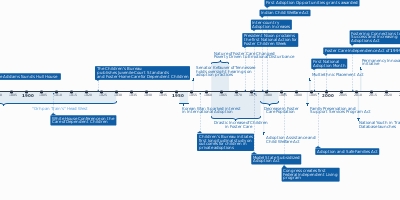Dramatic Increase
in Adoption
(Kahan, 2006) (oct 29, 1937 – oct 21, 1945)
Description:
Adoption increased dramatically during this period, tripling between 1937 and 1945, and then doubling again by 1955. For the first time, adopted children outnumbered institutionalized youth.
The reasons for this shift were twofold. First, illegitimate births increased significantly during the period, from some 130,000 children in 1948 to over 200,000 in 1958. As Carp states: "With social bonds loosened by wartime, illegitimacy rates began to soar, especially among nonwhites, continuing their upward flight for the next forty years" (2002, p. 12). At the same time, the demand for children to adopt grew as a result of the baby boom's rising marriage rates. During and after the war, parenthood was hailed as a patriotic duty. Childless couples were shunned, and record numbers sought adoption; "adoption agencies were inundated with requests for children" (Carp, 2002, p. 13). New medical treatments also enabled doctors to diagnose infertility earlier, leading couples seeking children to move on to adoption. Wartime prosperity also contributed to this trend of increased interest in adoption. Benet concludes: "The post-war increase in the popularity of adoption came about because it solved a particular social problem: the rise in white middle-class illegitimacy during the 'permissive society' of the 1950s ..." (1976, p. 16).
This growth led to many changes in adoption practice. Social workers continued gaining domain over the process. They worked to make adoption more acceptable by matching adoptive parents and adoptees according to physical, ethnic, racial, religious, and intellectual characteristics, creating adoptive families that resembled biological ones
As the demand for children was high, adoption workers were able to select the 'best' possible parent matches for adoptees. The best parents were those who appeared most 'normal'; "accepted couples were remarkably similar everywhere"
Other shifts that occurred during this period involved the composition of these new families. Birthparents gave their children up at earlier ages and adoptive parents began to express preferences for newborns. The proportion of adoptive parents who preferred newborns more than doubled between the 1930s and 1940s; by 1951, 70 percent of adoptees were under age one. Birthparents were also better educated and employed, while at the same time more likely to be single mothers. Rather than for reasons of poverty, like their predecessors in and before the Progressive Era, these women relinquished their children to avoid the stigma of illegitimacy. From their review of case records of the Children's Home Society of Washington from 1895 to 1973, Carp and Guerrero conclude: "the turning point in the ... adoptive parents' preferences and, by extension, the complete sentimentalization of adoption occurred not in the first quarter of the twentieth century but in the 1940s and 1950s"
Added to timeline:

Foster Care History
Date:
